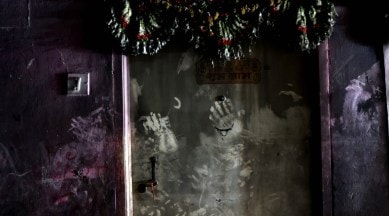Stay updated with the latest - Click here to follow us on Instagram
No fire-fighting system in place, narrow lane hampered rescue ops’
The building was constructed in 2008 by the SRA and, according to the rules, an SRA building is constructed by demolishing the slums on a particular land parcel in a bid to rehabilitate those who had been living in those shanties.

As seven persons, including two minors, lost their lives in the fire at Jay Bhavani residential building at Goregaon (west), fire officials confirmed that the building did not have any fire-fighting system. Besides, fire engines could not go near the building because of its location in a narrow lane and fire personnel used fire hoses and pipes from a distance to douse the blaze.
The blaze erupted in the stilt parking space in the basement, where combustible items like clothes were kept.
monthly limit of free stories.
with an Express account.
Mumbai Fire Brigade (MFB) officials said there were no fire extinguishers or sprinklers in at the basement.
Situated opposite Goregaon’s Azad Maidan, the Slum Rehabilitation Authority (SRA) building is accessible through a small lane, posing the biggest hurdle for fire-fighters. Because of the narrow lane, fire engines and tankers could not reach the building. “The fire engines could not go right near the building as only small vehicles can access the gully. We used fire hoses and pipes to douse the fire,” Additional Fire Divisional Officer (ADFO), Goregaon, Somnath Bhaye, told The Indian Express.
“We faced another set of challenges while carrying out rescue operations because of the absence of a fire-fighting system as well as the dense smoke and darkness,” he added.
Locals too said the MFB was handicapped by the narrow lane and the inability of the fire engines to enter the lane slowed down rescue operations.
Mayur Gosavi, a resident of a neighbouring building, said, “Even though the fire brigade deployed several vehicles to douse the flames, they did not know what to do with them. The fire engines couldn’t enter the narrow lane. Besides, a nearby MHADA building has a working fire hydrant system. However, the MFB did not use them.”
According to senior MFB officials, while the fire broke out in the stilt area of the building, the cause is yet to be ascertained.
On the absence of a fire-fighting system in the building, a senior BMC official, requesting anonymity, said, “The permission for construction was given around 2005. There was no compulsory provision of setting up inbuilt fire-fighting set-ups back then.”
“Also, this building was less than 24 metres in height, which is classified as a low-rise building; therefore, earlier there were no stringent guidelines in place for low-rise buildings and most of these rules were modified in the past one decade,” the official added.
According to urban planners and architects, the civic body must implement strict rules and follow certain standards while granting building permits, in a bid to avoid such mishaps. Urban planner Vivek Pai said that studies such as swept path analysis for fire tenders and human evacuation must be carried out before granting any approvals.
“Additionally, norms from National Fire Protection Association (NFPA) and National Building Code (NBC) should be made compulsory and added to the development control regulations. Also, the government should make a new authority for fire protection and disaster preparedness in large cities which can conduct audits of older buildings and densely populated areas,” added Pai.
The building was constructed in 2008 by the SRA and, according to the rules, an SRA building is constructed by demolishing the slums on a particular land parcel in a bid to rehabilitate those who had been living in those shanties.
Satish Lokhande, CEO of SRA, told The Indian Express that the building was issued an Occupation Certificate in 2013 by the Brihanmumbai Municipal Corporation (BMC). “The OC was issued in 2013 by the civic authorities, after that we (SRA) maintained the building till 2016 under the Defect Liability Period (DLP). Now the building was entirely under the ownership of private occupants and we didn’t have any official authorisation on the property,” Lokhande told The Indian Express.